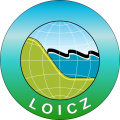LOICZ History
| The Past (1993 - 2002) |
 Loicz Logo Old
Loicz Logo Old
The LOICZ project commenced in 1993 with the establishment of the International Project Office (IPO) at the Netherlands Institute for Sea Research (NIOZ), Texel, The Netherlands. The Office has been financially supported by the Dutch Government. Operations followed the Science Plan (IGBP Report No. 25, 1993) and Implementation Strategy (IGBP Report No. 33, 1995). LOICZ was scheduled to run for 10 years.
In comparison with the relatively uniform environment of the sunlight zone of the open ocean, or the rapidly mixed environment of the atmosphere, the spatial and temporal heterogeneity of the world's coastal zones is considerable. As a consequence, there are significant methodological problems associated with developing global perspectives of the role of this compartment in the functioning of the total Earth System. Identifying and quantifying this role as well as developing scenarios of changes in the coastal zone under anthropogenic and geocentric driving forces require a considerable body of research.
The LOICZ Implementation Plan provided a blueprint of research and integrative activities to meet the project goals. Research and tasks were organized under four foci providing individual and national research that contributed to the overall goals of LOICZ. Framework activities provided mechanisms for coordination and consolidation of research results.
Unlike many of the other IGBP Core Projects, LOICZ dealt with a specific spatially heterogeneous domain rather than a process. To achieve the overall goals and objectives a global network of coastal scientists had to be developed. Funding and other support was provided from the Core Project to foster research especially in developing countries since their coastlines encompass the bulk of the world's tropical shores and are areas where the rates of anthropogenically driven change are considerable.
The objective of LOICZ was not to undertake coastal zone management. A clear goal was to provide a sound scientific basis to underpin future decisions for sustainable use by integrated management of land-ocean interactions.
| The Future (until 2015) |
 Loicz Logo new
Loicz Logo new
Based on the outcomes from the implementation of the first 10 years of activity, LOICZ has been identified as a continuing Core Project under IGBP II and, from 2004 also under IHDP. A new Science Plan and Implementation Strategy (SPIS) for a second phase of LOICZ has been developed. In this second phase LOICZ has an anticipated Lifetime until 2015. LOICZ recognizes the growing importance of linking coastal zone science to coastal zone management and this is reflected in the theme structure of the SPIS. The core purpose of LOICZ remains scientific research although with an increased focus on integrated analysis and synthesis that includes human dimensions. Operationally this requires the continued leadership of the LOICZ Scientific Steering Committee (SSC) supported by an effective IPO structure for management on a day to day basis. In order to enhance the regional activities of LOICZ, a distributed IPO node structure is being implemented. During the transitional period (2003-2005), in which LOICZ evolved into a fully interdisciplinary research project the Dutch Government has continued to support the IPO on Texel. To date, Regional Nodes have been established to cover Southeast Asia (NTU, Singapore), South Asia (NSF, Sri Lanka) and East Asia (YIC, China). A west african regional node supported by START and PARCOM promotes regional LOICZ implementation in Africa.
These Regional IPO Nodes will increase the presence of LOICZ regionally and provide greater opportunity and support of research as well as enhanced networking.
As of January 2006, the Central IPO is hosted by the Institute for Coastal Research at the GKSS Research Center in Geesthacht, Germany.
A globally distributed network of coastal zone researchers is carrying out much of the LOICZ research. From about 400 scientists involved in developing the first Science Plan published in 1993, this network now extends to 2000 scientists and stakeholders in 60-90 countries. National LOICZ contacts have been identified in many countries to provide a link between national and international LOICZ research activities. These people supported by the Regional Nodes will provide a focal point for those interested in getting additional information on local and national LOICZ research. Consequently, a major portion of LOICZ global research continues to be carried out by local and regional research projects.
Ongoing LOICZ Core Research Project activities from phase I (e.g. Biogeochemical Modeling, Typology and Coastal Classification) will continue and new core research fields are emerging with the development of the new SPIS. LOICZ will continue to seek strong collaboration with relevant partners within and beyond the Earth System Science Partnership of IGBP, IHDP, WCRP and DIVERSITAS.
Science Plan and Implementation Strategy
Institute for Coastal Research (IfK)
GKSS Research Centre / GKSS-Forschungszentrum Geesthacht GmbH
Earth System Science Partnership (ESSP)
International Geosphere-Biosphere Programme (IGBP)International Human Dimensions Programme on Global Environmental Change (IHDP)
World Meteorological Organization (WMO)




